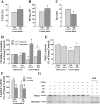Exposure to inhaled particulate matter impairs cardiac function in senescent mice
- PMID: 18448608
- PMCID: PMC2494811
- DOI: 10.1152/ajpregu.00697.2007
Exposure to inhaled particulate matter impairs cardiac function in senescent mice
Abstract
Daily exposure to particulate matter (PM) is known to adversely affect cardiac function and is also known to be exaggerated with senescence. This study tests the hypothesis that cardiac function is uniquely altered by PM exposure in senescent mice. A mechanism for PM-induced cardiac effects is also postulated by examining the activity of nitric oxide synthase (NOS) and the generation of reactive oxygen species (ROS) in heart tissue. Echocardiography is performed in awake 18- and 28-mo-old mice at baseline and immediately following 3-h exposures to either filtered air or carbon black (CB; approximately 400 microg/m3) on 4 days. At 28 mo, left ventricular diameter at end-systole and end-diastole is significantly (P < 0.05) elevated, and fractional shortening is significantly reduced (49 +/- 3% vs. 56 +/- 3%) with CB exposure. In vivo hemodynamic measurements at 28 mo also demonstrate significant (P < 0.05) reductions in ejection fraction and increases in right ventricular and pulmonary vascular pressures following CB exposure. Functional changes at 28 mo are associated with increased ROS production as suggested by enhanced luminol activity. This elevated ROS production with aging and CB exposure is attributable to NOS uncoupling. Measurements of natriuretic peptide (atrial and brain) transcription and matrix metalloproteinase (MMP2 and MMP9) activity in heart tissue are significantly (P < 0.05) amplified with senescence and exposure to CB, pointing to increased cardiac stress and remodeling. These results demonstrate that acute PM exposure reduces cardiac contractility in senescent mice, and this decline in function is associated with increased ROS production linked to NOS uncoupling.
Figures







Similar articles
-
Variation in echocardiographic and cardiac hemodynamic effects of PM and ozone inhalation exposure in strains related to Nppa and Npr1 gene knock-out mice.Inhal Toxicol. 2010 Jul;22(8):695-707. doi: 10.3109/08958378.2010.487549. Inhal Toxicol. 2010. PMID: 20540624
-
Effects of ozone and particulate matter on cardiac mechanics: role of the atrial natriuretic peptide gene.Toxicol Sci. 2013 Jan;131(1):95-107. doi: 10.1093/toxsci/kfs273. Epub 2012 Sep 13. Toxicol Sci. 2013. PMID: 22977167 Free PMC article.
-
Adverse cardiovascular effects with acute particulate matter and ozone exposures: interstrain variation in mice.Environ Health Perspect. 2008 Aug;116(8):1033-9. doi: 10.1289/ehp.10689. Environ Health Perspect. 2008. PMID: 18709144 Free PMC article.
-
Particle effects on heart-rate regulation in senescent mice.Inhal Toxicol. 2004 Jun;16(6-7):381-90. doi: 10.1080/08958370490439551. Inhal Toxicol. 2004. PMID: 15204754
-
The heart as an extravascular target of endothelin-1 in particulate matter-induced cardiac dysfunction.Pharmacol Ther. 2016 Sep;165:63-78. doi: 10.1016/j.pharmthera.2016.05.006. Epub 2016 May 21. Pharmacol Ther. 2016. PMID: 27222357 Free PMC article. Review.
Cited by
-
Exposure to diesel exhaust particulates induces cardiac dysfunction and remodeling.J Appl Physiol (1985). 2013 Oct 1;115(7):1099-106. doi: 10.1152/japplphysiol.00343.2013. Epub 2013 Jul 25. J Appl Physiol (1985). 2013. PMID: 23887904 Free PMC article.
-
Interstrain variation in cardiac and respiratory adaptation to repeated ozone and particulate matter exposures.Am J Physiol Regul Integr Comp Physiol. 2009 Apr;296(4):R1202-15. doi: 10.1152/ajpregu.90808.2008. Epub 2009 Jan 21. Am J Physiol Regul Integr Comp Physiol. 2009. PMID: 19158411 Free PMC article.
-
Effects of particulate air pollution on cardiovascular health: a population health risk assessment.PLoS One. 2012;7(3):e33385. doi: 10.1371/journal.pone.0033385. Epub 2012 Mar 14. PLoS One. 2012. PMID: 22432017 Free PMC article.
-
Environmentally persistent free radicals decrease cardiac function before and after ischemia/reperfusion injury in vivo.J Recept Signal Transduct Res. 2011 Apr;31(2):157-67. doi: 10.3109/10799893.2011.555767. J Recept Signal Transduct Res. 2011. PMID: 21385100 Free PMC article.
-
Inhalation of printer-emitted particles impairs cardiac conduction, hemodynamics, and autonomic regulation and induces arrhythmia and electrical remodeling in rats.Part Fibre Toxicol. 2020 Jan 29;17(1):7. doi: 10.1186/s12989-019-0335-z. Part Fibre Toxicol. 2020. PMID: 31996220 Free PMC article.
References
-
- Alderton WK, Angell AD, Craig C, Dawson J, Garvey E, Moncada S, Monkhouse J, Rees D, Russell LJ, Russell RJ, Schwartz S, Waslidge N, Knowles RG. GW274150 and GW273629 are potent and highly selective inhibitors of inducible nitric oxide synthase in vitro and in vivo. Br J Pharmacol 145: 301–312, 2005. - PMC - PubMed
-
- Bai Y, Suzuki AK, Sagai M. The cytotoxic effects of diesel exhaust particles on human pulmonary artery endothelial cells in vitro: role of active oxygen species. Free Radic Biol Med 30: 555–562, 2001. - PubMed
-
- Bianchi G, Di Giulio C, Rapino C, Rapino M, Antonucci A, Cataldi A. p53 and p66 proteins compete for hypoxia-inducible factor 1 alpha stabilization in young and old rat hearts exposed to intermittent hypoxia. Gerontology 52: 17–23, 2006. - PubMed
-
- Bilchick KC, Duncan JG, Ravi R, Takimoto E, Champion HC, Gao WD, Stull LB, Kass DA, Murphy AM. Heart failure-associated alterations in troponin I phosphorylation impair ventricular relaxation-afterload and force-frequency responses and systolic function. Am J Physiol Heart Circ Physiol 292: H318–H325, 2007. - PubMed
Publication types
MeSH terms
Substances
Grants and funding
LinkOut - more resources
Full Text Sources
Medical
Miscellaneous

